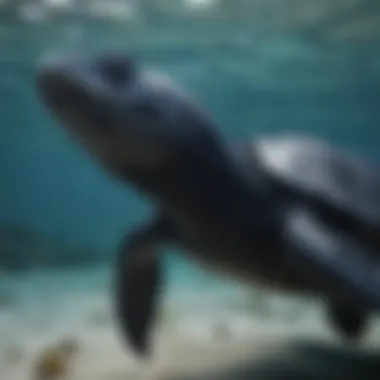The Endangered Status of Leatherback Turtles: An In-Depth Analysis


Nature Topic Overview
Leatherback turtles are a species of marine reptiles 🐢, known for their impressive size and distinctive leathery shell. This section will delve into the fascinating world of these creatures, shedding light on their characteristics, behavior, and significance in the global ecosystem.
Fun Facts and Trivia
Diving into the realm of leatherback turtles reveals intriguing facts that are sure to captivate young minds. Did you know that leatherback turtles can weigh up to 2,000 pounds and measure over six feet in length? These gentle giants have been navigating the oceans for over a hundred million years, showcasing remarkable resilience in the face of environmental challenges. Interactive elements such as puzzles and visuals will enhance the learning experience, making the exploration of these creatures even more engaging.
Wildlife Explorations
In the vast expanse of marine life, leatherback turtles stand out as a unique and irreplaceable species. Their role in ocean ecosystems, from seagrass beds to jellyfish populations, underscores their importance. By delving into different species related to them and understanding the intricate balance of marine habitats, young readers can grasp the interconnectedness of all living beings. Engaging features like quizzes will test their knowledge and expand their understanding of key environmental concepts.
Environmental Awareness
Conservation and sustainability efforts are crucial in protecting leatherback turtles and their habitats. Highlighting the importance of preserving biodiversity and fostering a sense of stewardship towards nature is key. Providing children with practical tips on how they can contribute to conservation initiatives empowers them to make a positive impact on the environment. Educating the younger generation on the significance of these magnificent creatures reinforces the importance of environmental awareness.
DIY Nature Activities


Offering hands-on activities and experiments related to leatherback turtles enables children to connect with nature on a deeper level. From creating turtle-themed crafts to embarking on outdoor explorations to observe local wildlife, there are endless opportunities to engage with the natural world. Step-by-step guides and detailed instructions will inspire young conservationists to take action, fostering a sense of curiosity and wonder towards the environment.
Introduction
Leatherback turtles, one of the ocean's most extraordinary inhabitants, evoke curiosity and concern in the hearts of many. This article embarks on a journey to unravel the intricate status of these majestic creatures, specifically focusing on whether they face the perilous label of endangerment. The importance of this exploration lies in shedding light on the pressing factors that threaten the existence of leatherback turtles, highlighting the urgency for conservation efforts. By delving into the depths of their plight, we aim to increase awareness and understanding surrounding the challenges these gentle giants endure in their oceanic realm.
In a world where biodiversity is increasingly at risk, examining the status of leatherback turtles holds significant relevance. These ancient reptiles, with their distinctive leathery shells and immense size, play a crucial role in marine ecosystems. Understanding the threats they encounter due to human activities and environmental changes is vital for acknowledging the intricate balance of nature that hinges on their survival. By unveiling the complexities of their endangered status, we can pave the way for informed conservation strategies and collective action towards safeguarding these captivating creatures for generations to come.
Overview of Leatherback Turtles
Leatherback turtles are a fascinating species of marine reptiles that hold a significant place in the ecosystem. Their unique characteristics and behaviors make them a subject of great interest for researchers and conservationists. The overview of leatherback turtles in this article provides a comprehensive look at their role in the environment and the challenges they face in the wild. By understanding the physical characteristics, habitat preferences, and nesting behaviors of these turtles, readers can grasp the crucial importance of protecting this endangered species.
Physical Characteristics
When examining the physical characteristics of leatherback turtles, several remarkable traits stand out. These turtles boast a distinctive shell that sets them apart from other marine turtles. Known for their leathery skin and flexible shell, leatherbacks are well-adapted to their oceanic lifestyle. With a streamlined body shape and powerful flippers, they are built for efficient swimming and diving in search of their favorite prey, jellyfish. Additionally, their sizeable size, reaching up to seven feet in length, adds to their awe-inspiring presence in the marine world.
Habitat and Distribution
Leatherback turtles' habitat and distribution play a crucial role in understanding the challenges they face. These magnificent creatures roam the world's oceans, adapting to various environments to survive. Their habitat encompasses both coastal regions and open seas, showcasing their remarkable ability to thrive in diverse settings. The distribution of leatherback turtles is vast, spanning across tropical and temperate waters worldwide. This extensive range highlights their nomadic nature as they traverse vast distances in search of food and nesting grounds. Understanding the habitat and distribution of leatherback turtles provides valuable insights into their behavior, migration patterns, and interaction with their surroundings.


Global Distribution
The global distribution of leatherback turtles is a testament to their adaptability and resilience. These marine giants can be found in oceans around the globe, from the Pacific to the Atlantic, and even venturing into the Indian Ocean. Their ability to traverse vast distances showcases their remarkable navigation skills and evolutionary adaptations. Leatherback turtles are known to migrate thousands of kilometers, navigating ocean currents and continental shelves with precision. This global distribution highlights the interconnectedness of marine ecosystems and the importance of conservation efforts on a global scale to protect these magnificent creatures for future generations.
Threats to Leatherback Turtles
Leatherback turtles face a myriad of threats in their natural habitats, making it imperative to delve deep into the factors endangering these fascinating marine creatures. Understanding the intricacies of these threats is critical to formulating effective conservation strategies. One of the primary threats to leatherback turtles is human activities, which have significantly contributed to their vulnerable status. Human encroachment on nesting beaches, pollution from various sources, and overfishing are among the key factors adversely impacting leatherback turtle populations. The destruction of important nesting sites due to coastal development further escalates the risks faced by these ancient creatures. By shining a spotlight on the specific role of human activities in the decline of leatherback turtles, we pave the way for informed decision-making and proactive conservation initiatives.
Human Activities
Exploring the detrimental effects of human activities on leatherback turtles uncovers a sobering reality. Human-induced threats pose a direct challenge to the survival of these magnificent creatures, necessitating a closer look at the repercussions of our actions. Pollution from plastic waste and oil spills poses a significant hazard to leatherback turtles, affecting their delicate marine ecosystems and food sources. Additionally, the accidental capture of turtles in fishing gear, known as bycatch, proves to be a considerable threat to their populations. Addressing these human-driven perils requires a holistic approach, involving community awareness, policy interventions, and sustainable fishing practices to mitigate the impacts on leatherback turtles. By highlighting the critical link between human activities and the endangerment of leatherback turtles, we emphasize the urgency of conservation efforts to secure a future for these ancient mariners.
Conservation Efforts
In the realm of safeguarding leatherback turtles, conservation efforts play a pivotal role in ensuring the survival of these remarkable creatures. These initiatives encompass a wide array of activities aimed at preserving habitats, mitigating human-induced threats, and promoting public awareness. Conservation efforts are essential in addressing the challenges faced by leatherback turtles, such as habitat destruction, pollution, and climate change.
One of the key elements of conservation efforts is habitat protection. By designating and safeguarding critical nesting beaches and foraging grounds, conservationists create safe spaces for leatherback turtles to thrive. Additionally, efforts are directed towards reducing plastic pollution and implementing sustainable fishing practices to prevent accidental bycatch, a significant threat to leatherback populations.


Furthermore, education and outreach programs are integral components of conservation efforts. These initiatives raise awareness about the importance of leatherback turtles in marine ecosystems and promote environmentally friendly practices among local communities and stakeholders. By fostering a sense of stewardship and cooperation, conservation efforts strive to garner support for long-term conservation measures.
Legislative Protection
Legislative protection plays a crucial role in bolstering conservation efforts for leatherback turtles. Laws and regulations established at the national and international levels serve to formalize conservation measures, provide legal frameworks for habitat preservation, and impose penalties for activities that harm leatherback populations.
At the national level, countries enact legislations that prohibit the exploitation of leatherback turtles, their eggs, and habitats. These laws often outline specific actions to combat illegal poaching, regulate coastal development near nesting beaches, and monitor fisheries to prevent incidental capture of turtles. Additionally, legislative measures may include the establishment of marine protected areas and the implementation of monitoring programs to track population trends.
On the international front, collaborative agreements and conventions enhance the protection of leatherback turtles across borders. Treaties such as the Convention on International Trade in Endangered Species of Wild Fauna and Flora (CITES) impose restrictions on the trade of leatherback products to curb demand and combat trafficking. Moreover, conventions like the Convention on Migratory Species (CMS) facilitate transboundary conservation efforts and promote cooperation among range states.
Research and Monitoring
In this pivotal section of the article, we delve into the significance of research and monitoring in understanding the status of leatherback turtles. Research plays a crucial role in providing valuable insights into the behaviors, habits, and threats faced by these magnificent creatures. By studying their movements, nesting patterns, and feeding grounds, researchers can identify key areas for conservation efforts. Monitoring, on the other hand, allows scientists to track populations, assess the effectiveness of conservation measures, and detect any emerging threats to leatherback turtles. It provides essential data for evaluating the success of conservation programs and informing future initiatives.
When it comes to research on leatherback turtles, various elements come into play. Studying their physiology, migration patterns, and genetic diversity enables scientists to gain a comprehensive understanding of their biology and ecology. By analyzing trends in population size, reproductive success, and survival rates, researchers can assess the overall health of leatherback turtle populations. Furthermore, research on the impact of climate change, pollution, and fishing activities helps identify the primary threats to their survival.
Monitoring efforts are equally crucial for the conservation of leatherback turtles. Through satellite tracking, tagging programs, and nesting surveys, scientists can gather vital information on the movements and nesting behavior of these turtles. By using advanced technologies such as GPS and remote sensing, researchers can monitor their migrations, identify critical habitats, and assess the effectiveness of marine protected areas. Long-term monitoring initiatives also provide valuable data for detecting trends in population dynamics, including shifts in distribution and abundance.
Conclusion
In examining the status of leatherback turtles and evaluating their endangered status, several crucial insights have emerged that underscore the significance of this topic. Firstly, the alarming decline in leatherback turtle populations due to various environmental and human-induced threats serves as a clarion call for urgent conservation actions. Their unique biological characteristics, such as their remarkable size and the ability to travel long distances, make them a vital component of marine ecosystems that must be safeguarded.
Moreover, the interconnectedness of leatherback turtles with marine habitats highlights the broader implications of their decline, emphasizing the need for holistic conservation strategies. By protecting leatherback turtles, we not only ensure the preservation of a majestic species but also contribute to the overall health and balance of marine environments worldwide.
Furthermore, the legislative efforts and conservation initiatives aimed at safeguarding leatherback turtles exemplify a collaborative approach involving policymakers, scientists, conservationists, and local communities. These concerted efforts signify a recognition of the intrinsic value of biodiversity and the importance of preserving our natural heritage for future generations.







